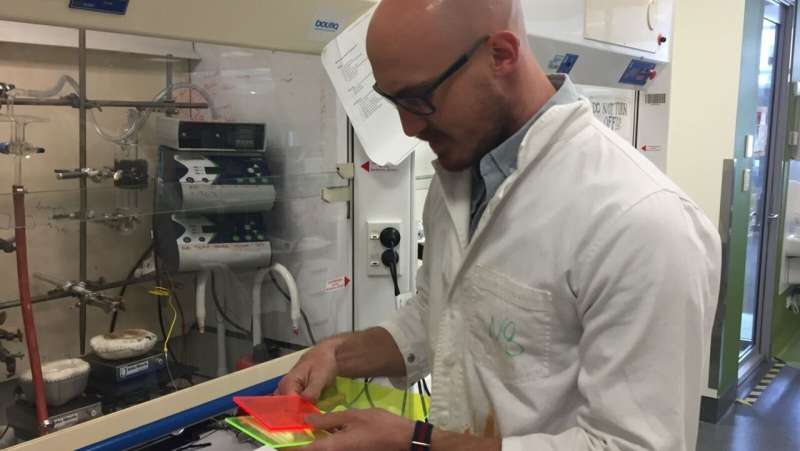Researchers close to turning point with solar power research

Dr. Nathaniel Davis from Te Herenga Waka-Victoria University of Wellington's School of Chemical and Physical Sciences says he and his research team are at a significant turning point in their solar power research.
Dr. Davis is working on a solar "paint." The paint is designed to go on the roof of a building to help better absorb the light need to power the building using solar power.
"You paint directly on to your roof and then install solar panels in the guttering," Dr. Davis says. "The paint contains luminescent molecules that absorb and emit light which guides the sunlight into the gutters and to the solar panels."
Unlike the larger (and more expensive) solar panels currently available, Dr. Davis' solution will involve one coat of paint and a narrow border of solar panels approximately the width of a finger. The combination of roof paint and small panels is designed to produce enough electricity to completely power a home.
An average solar panel system currently costs around $9000 in New Zealand for materials and installation. Dr. Davis says they expect the solar paint to be a very small fraction of that cost, because once painted on it will last for decades. It also won't require the installation of large, expensive solar panels, making it much more accessible to the average person. The system will also work in with any existing solar panel technology on the market.
"As well as having a positive impact on climate change and protecting the environment through renewable energy, this paint will also greatly reduce the cost of home electricity use," Dr. Davis says.
Dr. Davis has been working on this research for many years, exploring the concept during his honors year at the University of Sydney and then beginning to develop the work further during his Ph.D. and a research fellowship at the University of Cambridge. While studying overseas he worked on a technology called "solar concentrators," a small piece of technology set in a piece of plastic or glass that captures the sunlight and sends it sideways into solar panels.
After creating these panels, Dr. Davis began looking at creating different materials to help better capture sunlight, working with the established idea that the materials needed for a concentrator could actually be applied directly to a surface like a roof or a window frame, just like a regular house paint.
The idea for solar concentrators has been around since the 1970s, Dr. Davis says, but until now scientists have been unable to make it work on a commercial scale.
The final challenge Dr. Davis and his team are facing is making sure the paint doesn't simply reabsorb the light before it can be directed to the solar panels.
"We really are at the turning point," Dr. Davis says. "Once we reach this last hurdle, I can envision it becoming a product and seeing it on people's rooves within a couple of years."
Dr. Davis will work with the University's commercialisation office, Wellington UniVentures, to turn his invention into a commercial product. He will also be working with Resene Paints to develop the product for market.
Dr. Paul Geraghty, Commercialisation Manager at Wellington UniVentures says that this is an exciting area of research.
"The solar paint takes a unique approach to addressing the expensive module and installation costs that drive the price of traditional solar panels up for both commercial and residential use," Dr. Geraghty explains. "Wellington UniVentures is working closely with Dr. Davis as he undertakes this work."


















